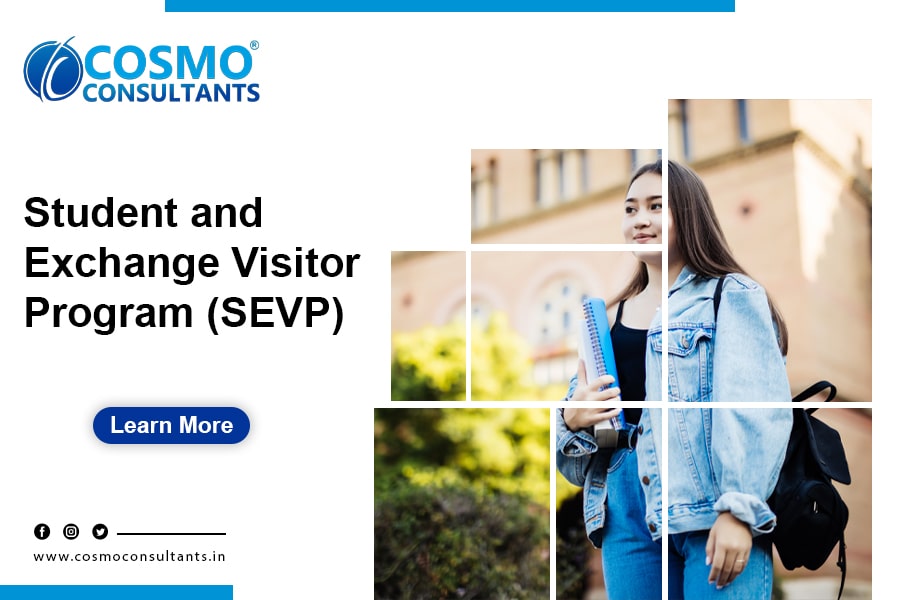
Welcome to our comprehensive guide about the Student and Exchange Visitor Program (SEVP) for
international students who wish to study in the USA. If you are a student or an exchange visitor
planning
to learn or participate in an exchange program in the United States, understanding the ins and
outs of
SEVP is very important.
Whether you're a prospective student, current participant, or DSO seeking clarity, this
guide will
demystify SEVP and help you make informed decisions about your study abroad aspirations.
The U.S. established the Student and Exchange Visitor Program (SEVP) to regulate and oversee
international students and exchange visitors studying in the country. It is responsible for
maintaining the
integrity of the U.S. immigration system about academic institutions and their international
student
populations.
The National Security Investigations Division's Student and Exchange Visitor Programme
(SEVP) serves as
a link for government agencies to learn more about non-immigrants who are entering the country
primarily to study.
SEVP ensures international students follow U.S. regulations and maintain legal status. Certified
schools
can issue important immigration documents like Form I-20 for student visas.
SEVP monitors and tracks international students' enrollment status, academic progress, and
compliance
with immigration rules. It sets guidelines and reporting requirements for schools and
universities to
follow, ensuring accurate record-keeping and adherence to immigration regulations.
SEVP offers benefits like practical training programs (OPT and CPT) for international students
to gain
work experience and employment authorization.
SEVP, the Student and Exchange Visitor Program, was established to promote security and facilitate academic and cultural exchange. It monitors international students and exchange visitors in the U.S., ensuring their legal status and fostering educational and cultural connections. SEVP bridges institutions, students, and the U.S. government to enhance safety, security, and global exchange.
The SEVP process involves various stakeholders, each playing a crucial role in maintaining the integrity of the program. Understanding the responsibilities and roles of these stakeholders is essential for navigating the SEVP successfully.
DSOs are the primary point of contact for SEVP-certified schools and programs. They act as liaisons between the school, students, and the U.S. government. DSOs are responsible for maintaining SEVP compliance, assisting students in maintaining their status and facilitating communication with the U.S. government on immigration-related matters.
These educational institutions and programs have undergone a rigorous certification process to ensure they meet SEVP's standards. They are responsible for providing quality education and maintaining compliance with SEVP regulations. SEVP-certified schools must have designated officials (DSOs) who oversee the program's implementation and ensure adherence to immigration laws.
International students and exchange visitors are essential stakeholders in the SEVP process. They must comply with SEVP regulations, maintain their legal status, and follow the rules set by their designated school officials. Students must also report any changes in their academic program, address, or personal information to their DSOs promptly.

SEVP offers several benefits for international students studying in the United States. Here are some key advantages:
SEVP ensures that international students maintain their legal status in the United States. By following SEVP regulations, students can study, live, and participate in practical training while abiding by U.S. immigration laws.
SEVP allows international students to access a wide range of educational opportunities in the United States. Students can choose from diverse academic programs, pursue degrees in various fields, and receive a high-quality education from prestigious American institutions.
SEVP offers practical training and employment authorization programs such as OPT and CPT. These programs enable students to gain valuable work experience in their field of study, enhancing their skills and employability.
U.S. institutions often have extensive networks and connections with industry professionals and potential employers. International students can leverage these networks to establish valuable connections, explore career opportunities, and enhance their professional prospects.
Studying abroad under SEVP offers a unique opportunity for personal growth and development. International students develop independence, adaptability, and resilience as they navigate a new country, culture, and educational system. They acquire valuable life skills that go beyond the classroom.
SEVP-certified schools provide various resources and support services for
international students. These can include academic advising, counselling, cultural integration
programs,
and assistance with immigration-related matters. These resources help students navigate the
challenges
of studying abroad and ensure a positive educational experience.
These benefits
contribute to a fulfilling and transformative overseas educational experience for
international students as they pursue their academic and career goals.
The SEVIS fee is a required payment for international students applying for a U.S. student visa.
It
supports the SEVIS system, which tracks and monitors international students in the United
States.
To pay the SEVIS fee for the US student visa application process, follow these
steps:
Before paying the SEVIS fee, you need to receive Form I-20 from the US academic institution you plan to attend. The institution's designated school official (DSO) will issue this form to you.
Go to the official SEVIS fee payment website SEVP portal to begin the payment process.
On the SEVIS fee payment website, provide the necessary information, including your details, SEVIS ID (found on your Form I-20), and the academic institution's name.
Choose your preferred payment method, such as a credit/debit card or electronic check, and complete the payment transaction. Remember to retain the payment confirmation receipt for future reference.
After paying the SEVIS fee, you will receive a payment confirmation receipt. Keep this receipt as proof of payment, as you may need to present it during your visa application process.
Be sure to pay the SEVIS fee well ahead of your USA visa interview or application submission. It's a vital step in the US student visa process and must be completed before proceeding with your study abroad application.

As an international student or exchange visitor participating in the SEVP, it is essential to understand and adhere to the regulations and requirements set forth by SEVP. Compliance with these regulations ensures that you maintain your legal status and have a successful educational experience. Here are some key regulations and requirements for students:
International students must maintain full-time enrollment, as defined by their program, to maintain their legal status. Dropping below full-time enrollment without authorization can result in a violation of status.
SEVP regulations allow for limited employment opportunities for international students. These opportunities include on-campus employment, curricular practical training (CPT), and optional practical training (OPT). It is crucial to understand the rules and restrictions associated with each type of employment authorization.
International students must keep their address and contact information up to date with their designated school officials. Failure to do so can result in a violation of status and potential consequences.
Upon completion of their program, students have a limited grace period to depart the United States or apply for further study or employment. It is essential to understand the specific grace period associated with your program and take appropriate action within that timeframe.
Following these regulations and requirements ensures international students maintain legal status and succeed academically in the United States. Non-compliance can lead to serious consequences. Let's examine the reporting and recordkeeping responsibilities for SEVP-certified schools and programs.
SEVP employs various methods to monitor and track international students studying in the United States. Here are some key aspects of how SEVP performs this task:
SEVP utilizes the Student and Exchange Visitor Information System (SEVIS), a web-based system that maintains data on international students, exchange visitors, and their dependents. Schools and designated school officials (DSOs) are responsible for entering and updating student information in SEVIS.
SEVP requires schools to maintain accurate and up-to-date student records, including information such as enrollment status, course load, and academic progress. DSOs regularly update these records to reflect any changes in student status or activities.
SEVP mandates that international students comply with check-in requirements, such as reporting to their designated school officials within a specified timeframe upon arrival in the United States. DSOs monitor students' compliance with reporting and maintain communication throughout their academic program.
Schools must fulfill reporting requirements set by SEVP, including submitting updates on student enrollment, program start and end dates, changes in address or contact information, and any other significant changes in a student's status. This ensures that SEVP maintains accurate and current information about international students.
SEVP may conduct site visits to schools hosting international students to verify compliance with SEVP regulations. During site visits, SEVP representatives review records, interview school officials, and assess compliance with program requirements.
SEVP employs data analysis techniques to identify patterns, trends, and potential
compliance issues. Analyzing student and school data helps identify any irregularities or
potential
violations, enabling SEVP to take appropriate action when necessary.
SEVP monitors and
tracks international students to ensure they follow immigration rules, maintain legal
status, and participate in valid educational activities while studying in the U.S.
SEVP is designed for international students who wish to study in the United States. Eligibility to participate in SEVP is determined by the specific requirements and guidelines set by the U.S. Department of Homeland Security (DHS). Generally, students with acceptance from a SEVP-certified school and a valid student visa can participate.
When an international student violates SEVP (Student and Exchange Visitor Program) regulations, there can be serious consequences. Here's what may happen if an international student violates SEVP regulations:
Violating SEVP regulations can lead to the loss of legal status for international students in the United States. This can result in the termination of their F or M student visa and potential removal or deportation from the country.
Violating SEVP regulations can make students ineligible for beneficial programs like Optional Practical Training (OPT) or Curricular Practical Training (CPT). These programs offer valuable work experience and employment authorization, but breaking SEVP rules can lead to losing these opportunities.
Violating SEVP regulations can have academic consequences as well. The student's enrollment may be impacted, and they could face disciplinary actions like probation, suspension, or expulsion from their academic institution.
Students who violate SEVP regulations may encounter challenges when reentering the United States in the future. Their visa applications may receive heightened scrutiny, and they may face additional questioning or delays during the visa process.
Violations of SEVP regulations can create a negative immigration record for the student, which can impact future visa applications or immigration-related processes. It may affect their eligibility for other visa categories or immigration benefits. International students must comply with SEVP regulations to safeguard their legal status and academic/professional prospects in the United States.
We hope this guide has empowered you to make informed decisions about your education and immigration journey. Don't miss out on this valuable resource! Take the first step towards a successful study abroad experience and unlock the doors to a world of possibilities. Visit Cosmo Consultants today and access our free study abroad counselling session. Your future awaits!
